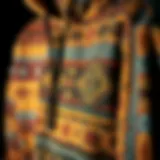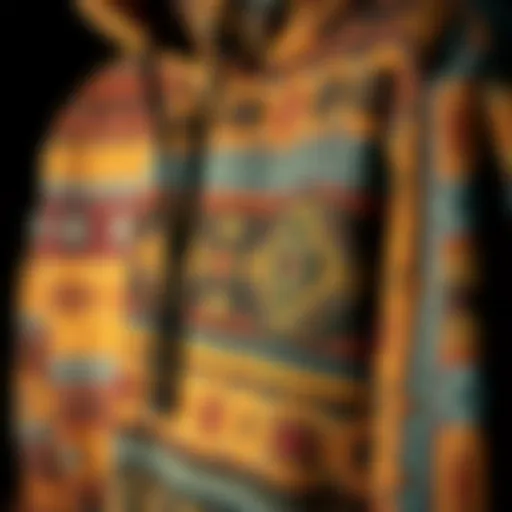Vans and Tie-Dye: A Deep Dive into Skate Culture
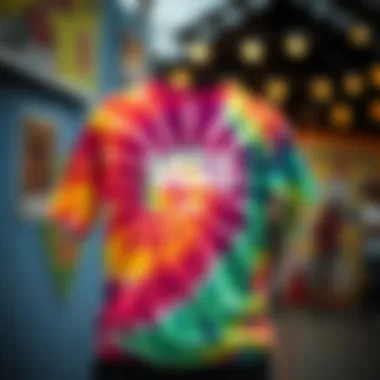
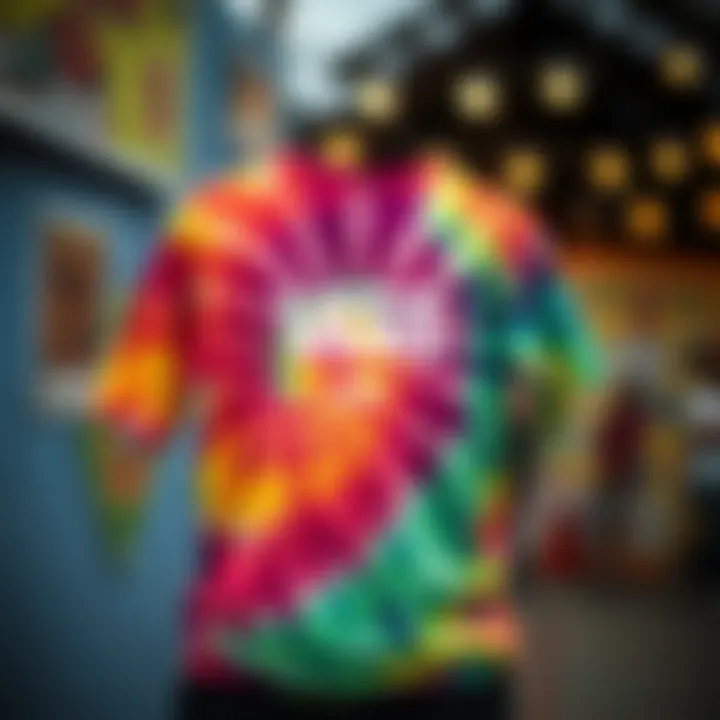
Intro
Skateboarding, much like the ocean, ebbs and flows with trends that shape its culture. One of the notable waves making its mark today includes the vibrant, swirling patterns of tie-dye that have mysteriously intertwined with the iconic brand, Vans. Popular among skateboarders and youth alike, Vans tie-dye shirts are not just a fashion statement; they are a canvas of self-expression, a nod to a vibrant culture that holds deep roots in freedom and rebellion. This exploration outlines the cultural significance of these shirts, their aesthetic appeal, and a closer look into how they reflect broader trends within skate fashion.
Skateboarding Techniques
Mastering the Basics
For anyone interested in skate culture, understanding the various skateboarding techniques is vital. Beginners often start with the basics, such as learning to balance on the board, pushing, and performing simple turns. These foundational skills are the stepping stones that lead to a more advanced repertoire. A skateboarder needs to feel the board beneath their feet, finding the sweet spot where gravity meets enthusiasm.
Some crucial fundamentals include:
- Balancing: Keep your knees bent and your center of gravity low.
- Pushing: Alternate between your dominant foot and the back foot to generate momentum.
- Turning: Lean in the direction you want to go, shifting your weight accordingly.
Advanced Tricks and Stunts
Once the essentials are mastered, the world of advanced tricks beckons, enticing those who crave adrenaline and challenge. Here, the aesthetics of skateboarding can also intersect with personal style, particularly through the adoption of tie-dye shirts that reflect an individual’s personality and artistry.
Popular advanced tricks include:
- Ollie: A fundamental jump technique that forms the basis for many tricks that follow.
- Kickflip: An ollie combined with a flick of the foot, making the board rotate underneath.
- Grind: Sliding along the edge of a rail or curb, showcasing both skill and confidence.
These maneuvers not only develop physical abilities but also foster a sense of community among skaters. Each trick often tells a story of persistence and creativity—much like the vibrancy of a tie-dye shirt that many skaters wear as a badge of honor.
Gear and Equipment
Skateboard Types and Features
Selecting the right gear plays a crucial role in a skateboarder's experience, and Vans has a knack for providing the right aesthetic and comfort through their clothing lines, including tie-dye shirts. Different types of skateboards cater to different styles of riding. Some popular options include:
- Street Skateboards: Designed for tricks, typically feature a wider deck to aid in landings.
- Longboards: Emphasizing cruising and speed, these often come with a longer deck and softer wheels.
- Cruisers: A blend of street and longboard features, perfect for quick rides and tricks.
Vans tie-dye shirts effortlessly blend into this diverse landscape, enhancing the skater's style while being functional and comfortable.
Essential Safety Gear
Safety should never be overlooked in the fast-paced world of skateboarding. While style is important, gear that ensures safety is just as essential. Common protective equipment includes:
- Helmets: Protecting the head is a must, especially when trying new tricks.
- Wrist Guards: These help prevent wrist injuries during falls, particularly for beginners.
- Knee Pads: Perfect for added protection, especially on rough terrains where falls are more likely.
Foreword to Vans and Its Place in Skate Culture
Vans has a long-standing reputation as a cornerstone of skate culture, reflecting not only a brand but a way of life for many. In this article, we will explore how Vans has intertwined with the very essence of skateboarding, offering skate enthusiasts an identity that marries style with functionality. This section sets the stage for understanding Vans' influence, not merely as a shoe brand but as a cultural phenomenon that resonates with skateboarders, parents, and retailers alike.
The Evolution of Vans as a Skateboarding Brand
Vans began its journey in 1966, started by Paul Van Doren and his partners in Anaheim, California. The brand originally focused on simple canvas shoes but quickly caught the attention of the burgeoning skateboarding community in the 1970s. Early on, skaters appreciated the durability and the grip offered by the brand's rubber soles. Over the years, this relationship blossomed as Vans harnessed the feedback from skaters to evolve its shoe designs, creating styles like the iconic Old Skool, a shoe that featured the now-iconic side stripe for added flair and stability.
As skate culture blossomed, so did Vans. The brand established iconic sponsorships and partnerships, associating it with legendary skaters like Tony Alva and Stacy Peralta. This enablended Vans to craft a skateboarding identity that was increasingly important in youth culture. Eventually, their shoes became synonymous with skateboarding itself, turning heads both at the skate park and beyond.
Vans' Core Values and Aesthetic
At the heart of Vans lies a philosophy that celebrates creativity, self-expression, and authenticity. These core values resonate deeply within the skate community. Skateboarding is about freedom—individuality thrives on the board and is reflected in the fashion choices made by skaters. Vans embodies this by constantly pushing boundaries and encouraging wearers to embrace their unique style.
The aesthetic of Vans can be described as raw, bold, and unapologetic. Unlike many mainstream brands that lean on sleek and polished looks, Vans opts for a minimalist yet expressive approach. From checkerboard patterns to various tie-dye designs, the brand harnesses a sense of nostalgia and incorporates elements directly from the culture it serves. What makes Vans particularly appealing is the versatility—pairing them with jeans, shorts, or even skirts caters to a broad audience, creating an inclusive community that celebrates diversity in style.
In summary, Vans' evolution as a skateboarding brand and its core values are critical to understanding its significance in skate culture. These elements lay the foundation for the subsequent exploration of tie-dye aesthetics and their interplay with the skateboarding community.
Understanding Tie-Dye: Historical Context
The story of tie-dye is far more than just vibrant colors and swirling patterns. Understanding its historical context is crucial for recognizing why this art form resonates within the realms of skateboarding and beyond. Originating as a textile technique, tie-dye's allure stems from its roots in both ancient cultures and modern subcultures alike, serving as a channel for self-expression and identity.
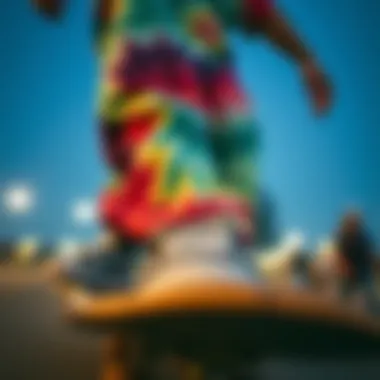

Origins of Tie-Dye as a Technique
Tie-dye can trace its heritage back to ancient civilizations, where intricate patterns were created using several knotting and binding methods. For instance, in areas such as Africa and Asia, artisans would wrap and twist fabric before applying dyes, resulting in unique designs that told stories or signified status. These techniques have survived and evolved, finding their way into different cultures across the globe.
In particular, Japanese shibori techniques are some of the most celebrated. This method relies on folding, twisting, and binding the fabric, resulting in astonishing patterns that vary greatly. In India, bandhani follows a similar path, where small sections of cloth are tied off, creating dots of color that bounce off contrasting hues. This rich history underscores the fact that tie-dye isn’t a mere trend; it’s a significant, cultural weave that encapsulates various time periods and peoples.
Tie-Dye in Popular Culture: A Retrospective
When we think of tie-dye today, it conjures images of the psychedelic '60s with bohemians and rock 'n roll. The emergence of the counterculture movement had a massive impact on the popularity of this fabric style. Tie-dye became a bold statement of rebellion against mainstream values, merging fashion with a philosophy that promoted peace, love, and freedom.
In the 1970s, the practice exploded in the United States, with the proliferation of DIY kits making it accessible to the masses. From T-shirts to scarves, its loud colors invited individuals to express their creativity at a time when self-identity was becoming increasingly important in society.
Fast forward to the present, tie-dye remains relevant, especially within the skate community. This is a haven for self-expression, where individuality runs wild. Today, brands like Vans incorporate tie-dye into their clothing lines, merging a classic style with skate culture's vibrant energy. The appeal is about more than just looking good; it reflects personal liberation and a visible challenge to conformity.
The resurgence of tie-dye in contemporary fashion is not simply about nostalgia; it's about ongoing dialogues in youth culture surrounding identity and communal ties.
Aesthetic Appeal of Tie-Dye Shirts
The aesthetic appeal of tie-dye shirts forms a vital part of the ongoing exploration of their impact within skate culture. These shirts transcend mere clothing; they serve as a canvas that showcases individuality, creativity, and a unique style that resonates with diverse audiences. The vibrant colors and patterns of tie-dye embody a playful spirit, inviting personal expression and artistic exploration. As skate culture continues to evolve, the visual language of tie-dye offers commentary on self-identity and community, blending art with fashion in an organic dance of colors.
Color Psychology in Tie-Dye Patterns
Color psychology plays a significant role in understanding the allure of tie-dye patterns. Different hues evoke varied emotions and reactions, and the use of these colors in tie-dye serves to enhance the wearer’s mood and the message they want to convey.
- Warm Colors: Shades like red, orange, and yellow often signify energy, passion, and enthusiasm. Wearing bright tie-dye shirts can inspire confidence and invigorate the wearer, setting a lively tone for their day, whether they're prepping for a skate session or just hanging out.
- Cool Colors: Blues, greens, and purples tend to emit tranquility and harmony. A cooler palette in tie-dye can create a sense of calm that complements the relaxed nature of skateboarding, allowing skaters to express their laid-back attitude while still standing out in a crowd.
- Mixed Colors: The haphazard charm of tie-dye, where various colors intertwine, creates a vibrant chaos that can symbolize freedom and rebellion, deeply connected to the essence of skate culture.
By understanding these psychological underpinnings, one can appreciate how each tie-dye shirt isn't just about aesthetics; it’s also about the emotional experience it provides to both the wearer and those around them.
Uniqueness and Individuality in Design
One of the standout features of tie-dye shirts is their inherent uniqueness. Each shirt emerges from the dyeing process bearing its own set of imperfections and designs, ensuring that no two pieces are the same. This characteristic strikes a chord with skateboarders, a group that often prides itself on individuality and standing apart from the mainstream.
- Personal Expression: Just as each skater develops their own style on the board, tie-dye provides a medium for them to express their personality off the board. Whether it’s bright swirling colors or earthy tones, these shirts allow the wearer to make a statement without saying a word.
- DIY Culture: The rise of customized tie-dye shirts aligns perfectly with the do-it-yourself ethos that is integral to skateboards. Many skaters choose to create their own designs, mixing colors and patterns that reflect their individual experiences and tastes. This hands-on approach fosters a deeper connection between the wearer and their attire, solidifying the role of tie-dye in the broader narrative of self-exploration.
"In a world where everyone is trying to fit in, tie-dye stands out as a loud whisper of a personal story, painted in vibrant hues."
In addition to the aesthetic value, tie-dye shirts offer a canvas for personal stories. Each shirt can showcase one’s journey, values, or even a rebellious spirit that resonates with skate culture. Collectively, these elements reveal why tie-dye is more than just a fashion choice — it's a reflection of personal identity woven into the very fabric of skateboarding culture.
Vans Tie-Dye Shirts: A Fashion Statement
Vans tie-dye shirts are not just pieces of clothing; they're a manifestation of an ethos that bridges artistic expression and the rebellious spirit of skate culture. As skateboarding evolves, so do its aesthetic choices, with tie-dye emerging as a prominent visual trend. This intersection creates a rich tapestry—one where vibrant colors collide with the carefree nature of skateboarding, establishing a unique fashion statement. In the world of Vans, the combination of tie-dye and skate culture represents a broader narrative about individuality and creativity.
These shirts have the ability to transform the mundane into the extraordinary, making them indispensable in the wardrobes of skateboarders and fashion enthusiasts alike. Wearing a tie-dye shirt is akin to donning a badge of honor in the skate community, symbolizing acceptance and a free spirit. The designs are not just vibrant; they showcase a certain attitude that aligns with the lifestyle that skaters embody.
Popular Designs and Collaborations
Vans has teamed up with various artists and designers to create exclusive tie-dye collections. Some of the standout pieces feature bold, swirling colors, embodying the essence of a carefree summer day. For instance, the Vans x Takashi Murakami collaboration included his iconic flower motifs splashed across classic Vans silhouettes, merging streetwear with fine art.
These limited-edition designs often sell out quickly, highlighting the high demand for unique pieces within the skate community. Not only do these collaborations push the envelope of creativity, but they also illustrate the brand's commitment to offering skateboards something fresh and exciting.
- Vans Tie-Dye 3-Pack: A collection of classic tees featuring subtle, pastel tie-dye patterns that resonate well with the skate style yet maintain a relaxed vibe.
- Vans Authentic: The classic shoes adorned with swatches of tie-dye can often be found at skate parks, reflecting the trend's crossover appeal.
These limited releases capture the essence of seasonal skate trends, helping aficionados express themselves visually through their clothing.
Aligning with Skateboarder Identity
For many skateboarders, tie-dye is more than just a fashion choice; it's a lifestyle. The bright colors and organic patterns reflect a rejection of conformity and a celebration of freedom. Each shirt tells a story, influenced by the personality of the wearer and the environment they skate in. This element of self-expression is crucial in a culture that thrives on authenticity and creativity.
Skateboarding has always celebrated the individual—the skater who dares to be different. The vibrant hues of tie-dye resonate deeply with this notion, as each design is distinct and unrepeatable, much like the tricks and styles that skaters develop. The use of tie-dye can serve as a form of protest against the homogenization of fashion, emphasizing that true style is about personal expression rather than adherence to trends.
Moreover, for many, the act of wearing a tie-dye shirt can forge connections in the skate community, allowing wearers to bond over similar aesthetics or shared experiences. As they skate, the colorful patterns carry this rich cultural symbolism, acting as a visual dialogue about rebellion and communal identity:
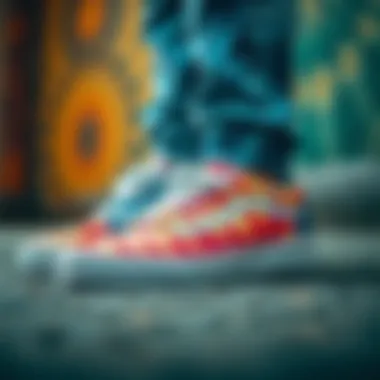

"To skate is to express; to wear tie-dye is to declare your individuality."
This alignment goes beyond mere aesthetics—it's about belonging to a vibrant community, where clothing choices become part of an ongoing narrative about self-discovery and artistic expression.
Cultural Significance of Tie-Dye in Skateboarding
Tie-dye, with its swirling colors and eccentric designs, is more than just a fabric technique; it embodies a myriad of cultural sentiments, particularly within the skateboarding community. The usage of tie-dye clothing among skateboarders transcends mere aesthetics, tapping into deeper themes of individuality, rebellion, and freedom. This section unpacks the significance of tie-dye in skate culture, illustrating how this visual language fosters a sense of identity for many.
Tie-Dye as a Symbol of Rebellion and Freedom
From its roots in the counterculture movements of the 1960s and 70s, tie-dye has often been a badge of rebellion against convention. Skateboarding, too, shares this spirit, often standing in direct opposition to mainstream sports and societal norms. It’s a form of expression; a medium through which individuals can voice their uniqueness and defiance. Skateboarders often face judgment and stereotype—dressed in tattered jeans and bright tie-dye shirts, they challenge societal expectations.
Key points to consider:
- Visual Impact: The bold colors and patterns of tie-dye represent a lack of conformity and a disdain for the ordinary.
- Cultural Heritage: The technique itself harkens back to traditional practices across various cultures, enhancing its symbolic nature. It’s a reminder of the importance of self-expression.
- Subversion: Wearing tie-dye can be seen as a statement against the polished aesthetics of mainstream fashion, embracing a look that celebrates the imperfections and fluidity of life.
"Fashion is what you’re offered four times a year by designers. And style is what you choose." — Lauren Hutton
This quote underscores the essence of tie-dye within the skateboard community. It’s not just a fashion choice; it’s a style imbued with personal significance.
Community and Identity through Fashion Choices
Within the skateboarding scene, clothing like tie-dye shirts creates bonds among individuals and forges a community united by shared interests and ethos. The idea of wearing one's emotions fosters connections that transcend mere friendship; it cultivates a sense of belonging.
- Tribal Connection: Tie-dye shirts often serve as informal uniforms in skate parks, symbolizing unity among skateboarders. The bright, quirky patterns allow riders to identify with one another easily, reinforcing community ties.
- Personal Narratives: Each tie-dyed piece can tell a story, such as where it was acquired or who made it. This narrative aspect adds value beyond the physical object, allowing wearers to express their journey and experiences.
- Inclusivity: The diverse range of colors and patterns makes tie-dye fashion accessible for everyone. This openness mirrors the inclusive nature of skateboarding; people from all backgrounds come together to share their love for skate culture.
In this way, the significance of tie-dye goes beyond being just a trend; it encapsulates the very spirit of skateboarding itself—celebrating freedom, individuality, and community. For skateboarders, these aspects provide a much-needed refuge from the pressures of modern life, reinforcing their identities not just as riders but as part of a larger collective. Whether a seasoned pro or a newcomer, tie-dye becomes a symbol of belonging in a vibrant culture.
Sustainability in Tie-Dye Fashion
The relevance of sustainability in the fashion industry cannot be understated, and it resonates deeply within the realm of tie-dye. As trends shift towards conscientious consumerism, the impact of production practices becomes scrutinized more than ever. This section delves into sustainability's role in tie-dye fashion, highlighting not only the benefits but also the considerations that skateboarders and fashion enthusiasts face today.
Embracing sustainable approaches fosters an awareness of environmental responsibilities. Consumers are increasingly inclined towards brands that showcase eco-friendly methods, which aligns with issues of waste reduction and ethical production. In skate culture, where individuality is crucial, adopting sustainable materials and processes can serve as a personal statement—people skate not just for the thrill but for the expression of their values, which now includes a commitment to maintaining our planet.
Eco-Friendly Practices in Production
When discussing sustainability, the focus often lands on transparent and responsible production practices. Many companies are now adopting eco-conscious methodologies in the tie-dye process.
- Natural Dyes:
Utilizing plant-based dyes from sources like turmeric, indigo, and beetroot drastically reduces chemical runoff and waste. This not only benefits the environment but can produce unique color palettes unavailable with synthetic dyes. - Water Conservation:
Innovative techniques that minimize water usage during dyeing processes are emerging. Brands are now exploring dyeing methods requiring less water, which conserves this critical resource. - Recycled Materials:
The integration of recycled fabrics into tie-dye collections is becoming the norm. By using materials like post-consumer polyester or organic cotton, manufacturers reduce the pressure placed on virgin resources. - Responsible Sourcing:
Selecting materials that are certified organic or made from recycled substrate also signifies a brand’s commitment to sustainability. This practice extends a brand's credibility, setting a precedent that eco-friendliness doesn't mean compromising on design or quality.
“True sustainability goes beyond trends; it’s about establishing practices that resonate with tomorrow's consumers.”
The Rise of Sustainable Clothing Brands
As the demand for sustainable fashion reverberates throughout the marketplace, an array of brands have begun to carve out a niche in the skate community.
- Emerging Labels: New brands, like Huf and Folk, focus on reducing their carbon footprint while producing tie-dye apparel that appeals to skate enthusiasts. These companies not only prioritize eco-friendly practices but also adhere to appealing designs that resonate with consumers.
- Established Brands Adapting: Even renowned names like Vans are stepping up their game, collaborating with sustainable initiatives and launching collections that emphasize eco-consciousness. This shift highlights the versatility of tie-dye as a fashionable choice that aligns with responsible practices.
By embracing sustainability, brands convert fashion into a means of personal expression while advocating for the planet. Skateboarders and consumers at large are more aligned with brands that contribute positively to society, elevating their choice of tie-dye not just as a style statement, but as a reflection of their values. The future lies in a seamless blend of creativity and responsibility.
Consumer Perception and Market Trends
Understanding consumer perception in today’s fashion landscape is crucial, especially within the realm of skate culture where authenticity and individualism reign supreme. Vans tie-dye shirts are not just clothing items; they represent a lifestyle that resonates deeply with skateboarders and youth alike. The significance of consumer perception is multifaceted, influencing not only purchasing decisions but also shaping brand loyalty and community identity.
In skateboarding culture, brands like Vans have historically held a prominent place. As such, consumers are not merely buying a shirt; they’re opting into a narrative, one that reflects their values, aesthetics, and social identity. According to fashion experts, the connection between product and personal identity has been amplified in recent years. Shoppers, especially in skate culture, are looking for brands that resonate with their beliefs, which often include sustainability, artistic expression, and authenticity. This explains why the tie-dye trend has taken off with such fervor; it speaks to a desire for uniqueness in a world saturated with sameness.
The market trends indicate that tie-dye clothing is more than just a passing phase. Reportedly, people view these shirts as collectible pieces, each uniquely crafted and representing the wearer's personality. This gives a hefty boost to the resale market, where tie-dye designs are particularly sought after.
Furthermore, the fashion world is currently witnessing a notable shift towards ethically produced clothing, and this is particularly evident within the skating community. This intersection of sustainability and self-expression creates a compelling narrative around Vans tie-dye shirts, making them a central topic in consumer discussions. As a result, the relationship between the brand and its consumers has evolved from a transactional nature to one that incorporates emotional investments.
"In many ways, the clothes we choose are a reflection of our identities, especially in cultures that appreciate individuality."
The Influence of Social Media on Fashion Choices
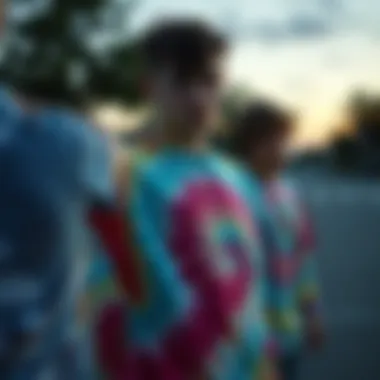

The role of social media in shaping fashion choices cannot be overstated. Platforms such as Instagram, TikTok, and Pinterest have become hotbeds for trend discovery and dissemination. For Vans tie-dye shirts, social media serves as a canvas where users showcase their unique style, creating a ripple effect across their followers. Influencers and everyday users alike post images and videos that highlight how these shirts can be incorporated into various personal styles, ultimately influencing their audience's perception and purchasing decisions.
In skate culture, social media creates an avenue for community interaction and brand engagement. Skateboarders eagerly share their favorite outfits, including the latest tie-dye designs from Vans. The vibrant imagery often leads to an engaging comment section, where people exchange ideas, tips, and feedback, strengthening their bonds within the skating community.
Moreover, the application of specific hashtags related to Vans and tie-dye allows users to track trends in real-time, ensuring that styles remain fresh and relevant. This visibility encourages not just buying decisions but inspires creativity in how tie-dye is styled. It’s not uncommon to find DIY tutorials shared as well, fostering a sense of belonging and individual expression within the skateboarding subculture. Social media's reach amplifies the individualized consumer narrative, making it apparent that fashion is not solely about personal aesthetics; it’s about being part of something bigger.
Demographics of Vans Tie-Dye Shirt Consumers
Examining the demographics of those who gravitate towards Vans tie-dye shirts exhibits various interesting insights. Primarily, the consumers tend to fall within the younger segments of the population, particularly teenagers and young adults aged 16 to 30—a demographic known for embracing distinctive trends and pushing boundaries.
This audience seeks not only fashion statements but also brands that represent their ideals. Typically, they are environmentally conscious and desire clothing that symbolizes self-expression. According to surveys, a notable portion of Vans tie-dye shirt buyers identifies as skaters or closely aligned with skate culture. However, it doesn't stop there; the appeal has stretched beyond traditional skaters to encompass casual wearers who appreciate the tie-dye aesthetic for its vibrancy and uniqueness.
Some key breakdowns of this demographic include:
- Age Group: Predominantly young adults and teenagers.
- Gender: A fairly balanced appeal spanning across male and female consumers.
- Interest: Enthusiasts of streetwear and casual fashion who are not necessarily skaters but appreciate the skate culture aesthetics.
- Geographic Spread: While Vans is a global brand, regions with a vibrant skate scene, like California and New York, show a higher concentration of consumers.
Personal Expression Through Tie-Dye
The tie-dye phenomenon is not just a trend; it is a radical form of self-expression, particularly prevalent among those who identify with skate culture. For many skateboarders, the practice of wearing or creating tie-dye represents more than fashion—it is a canvas signaling individuality and creativity. In this fast-paced world, where uniformity often reigns, tie-dye stands out, offering skateboarders a unique way to flaunt their personalities. The kaleidoscope of shapes and colors associated with tie-dye captured the hearts of many because each piece tells a different story.
DIY Tie-Dye Methods for Personal Customization
DIY tie-dye is not just about splashing colors on a t-shirt; it’s about immersing oneself in the creative process. By making their own tie-dye shirts, skateboarders have the opportunity to express distinct tastes and preferences. Here’s how you can embark on this colorful journey:
- Materials Required:
- Preparation: Start by pre-washing the shirt to remove any residues that might interfere with dye absorption.
- Tie-Dye Technique:
- Setting the Dye: Wrap the dyed shirt in plastic and let it sit for several hours, preferably overnight. This allows the dye to set.
- Final Wash: Rinse the shirt until the water runs clear, then wash it alone in the machine. Allow it to dry completely.
- A plain white or light-colored cotton shirt
- Fabric dye or tie-dye kit
- Rubber bands or string
- Plastic gloves
- Plastic wrap or plastic bags
- Water and spray bottles
- Spiral: Gather fabric at the center and twist it, securing with rubber bands. Apply dye in sections.
- Folded Stripes: Fan-fold the fabric lengthwise and bind with rubber bands; then, apply dye along the folds.
- Scribble: Crumple the fabric randomly, then secure tightly with rubber bands and apply dye wherever
The beauty of DIY is that no two shirts will ever be alike. Each skateboarder can let their imagination run wild, creating wearable art that reflects their personal journey.
The Role of Fashion in Self-Identity
In the skateboarding realm, fashion goes beyond mere clothing; it acts as a pivotal element of self-identity. The way skateboarders present themselves often speaks volumes about their values, attitudes, and influences. Tie-dye shirts serve as a vehicle for self-identification, allowing individuals to showcase their personal aesthetics while also embodying the free-spirited nature of skate culture.
"Fashion is not just what you wear; it’s a way of expressing who you are without having to say a word."
Skateboarders wearing tie-dye convey a sense of connection to the rebellious history of the culture. It taps into a rich vein of youth identity, drawing from eras of counterculture.
In both urban and suburban settings, tie-dye connects individuals who share similar passions and attitudes. Whether you’re a seasoned skater or just starting, sporting a tie-dye shirt means joining a colorful community where harmony and individuality coexist.
Ultimately, tie-dye in skate culture encapsulates the spirit of daring to be different, making a loud statement while simultaneously allowing room for self-exploration. It intertwines personal expression with fashion trends, proving that even amidst the fast-moving world of skateboarding, there are still vibrant threads of creativity beautifully spun together.
Ending: The Future of Vans Tie-Dye Shirts in Skate Culture
As we look ahead, the intersection of Vans tie-dye shirts and skate culture continues to evolve, reflecting shifts in aesthetics and societal attitudes. This blend of creative expression and youth culture is not merely a fad, but a dynamic relationship that invites deeper understanding. Understanding this interplay is essential because it reveals how fashion can articulate identity and freedom, particularly within communities like skateboarding, where individuality is key.
Evolving Trends in Skateboarding Fashion
The world of skateboarding fashion is in a constant state of flux. New trends emerge, often influenced by cultural shifts and technological advancements. Today, there is a growing inclination towards sustainability. Skateboarders are becoming increasingly conscious about their fashion choices, favoring brands that prioritize environmentally friendly practices.
This is where Vans plays a significant role. Known for their durable and timeless designs, Vans is adapting its production to meet the demands of eco-conscious consumers. Innovations like water-based inks and organic cotton are becoming staples in their tie-dye collections. The kaleidoscope of colors typically associated with tie-dye reflects diversity in skate culture, and as more skateboarders embrace eco-friendly practices, it opens avenues for the brand to explore new color palettes aligned with sustainability.
- Street Style Evolution: The fusion of elements from hip-hop, punk, and traditional skate styles introduces new aesthetics.
- Inclusivity in Design: Brands are expanding their offerings to cater to varied body types, ages, and styles, fostering a welcoming environment in skateboarding.
- Tech Integration: From performance-enhancing materials to augmented reality experiences revolving around fashion, technology is reshaping how skateboarders view and interact with their clothing.
Enduring Appeal of Tie-Dye Among New Generations
For younger generations, tie-dye denotes more than just a pattern; it's a symbol of rebellion, creativity, and the refusal to conform. The chaotic yet harmonious designs resonate with their desire for authenticity. Each tie-dye shirt tells a story—whether it’s the first shirt they made during a DIY weekend project or one bought from a local skate shop that became a staple in their wardrobe.
- Cultural Rebirth: Tie-dye's resurgence speaks to nostalgia while embodying a modern twist that appeals to youth culture. This concept evolves continually, maintaining relevance.
- Personal Expression: The DIY nature of tie-dye allows skateboarders to express individuality. With simple techniques, one can create a unique piece that represents themselves, making it a favored choice among creative types.
- Social Media Influence: Platforms like Instagram and TikTok amplify tie-dye's visibility, as influencers showcase their own takes on these designs, further cementing their popularity.
In essence, Vans tie-dye shirts are not just articles of clothing; they are statements of identity, freedom, and community. The future holds exciting possibilities as styles evolve and new generations embrace both the cultural roots and contemporary relevance of skate fashion. Understanding this intersection is not only pertinent for aficionados but is also crucial for brands aiming to capture the spirit of skate culture.
"Fashion is about something that comes from within you." - Ralph Lauren
As we witness new trends and paradigms emerge, it's clear that the narrative of Vans and tie-dye in skate culture will continue to unravel in fascinating ways.












